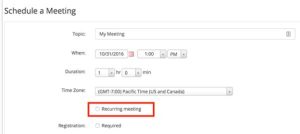What Defines a Recurring Meeting on Zoom?
In today's digital landscape, recurring meetings on Zoom stand as a cornerstone for continuous collaboration and connection across various domains, including business, education, and personal communication. A recurring meeting on Zoom is characterized by its ability to run at regular intervals without the need to set up a new meeting each time. This consistency is crucial for ongoing projects, regular team check-ins, or weekly classes.

Core Elements of a Recurring Meeting
A recurring meeting on Zoom is identified by several specific settings that automate the process of meeting on a regular schedule. Here's what makes up the DNA of these meetings:
- Frequency Options: You can choose how often the meeting repeats, such as daily, weekly, bi-weekly, or monthly. This flexibility ensures that the scheduling meets the specific rhythm of your project or team dynamic.
- Consistent Meeting ID: Unlike one-time meetings, a recurring meeting maintains the same meeting ID and link for each session. This consistency reduces confusion and simplifies access for all participants.
- Customizable Recurrence Patterns: You have the option to set the exact pattern of recurrence, specifying days of the week or the day of the month, and even adjust these patterns mid-sequence if needed.
Setting Up a Recurring Meeting
To set up a recurring meeting, you first access the scheduling function on your Zoom dashboard. After entering the basic meeting details—like title, description, and initial timing—you’ll select the Recurring meeting option to unlock the scheduling features specific to repeated sessions. Here, you detail the recurrence, choosing how many times or until when the meeting should repeat.
Adjustable Security Features: For recurring meetings, Zoom allows you to set or change passwords, enable waiting rooms, and control participant actions such as screen sharing. These settings can be adjusted at any time to increase security or adapt to changing needs.
Benefits of Using Recurring Meetings
Organizations and groups benefit from recurring meetings by:
- Saving Time: Automating the scheduling process saves administrative time and lets you focus more on meeting content rather than logistics.
- Improving Consistency: Regular intervals help in building a routine and expectation, which can enhance participation and engagement.
- Facilitating Long-term Planning: With meetings penciled in weeks or months ahead, all parties can plan their schedules more effectively.
Optimizing Recurring Meetings on Zoom
To maximize the effectiveness of your recurring meetings, consider these strategies:
- Regularly Update Settings: Keep your meeting settings and participant permissions up to date to match the evolving needs of your group.
- Seek Participant Feedback: Encourage feedback to continuously tailor the meeting format and content, ensuring it meets the group’s needs.
- Monitor Engagement: Use Zoom’s analytics tools to track attendance and participation, which can provide insights for improving meeting impact.
Incorporating these elements into your planning will ensure that your recurring meetings are not just a fixture in the calendar, but a productive and engaging part of your routine.
For a deeper dive into how to effectively recurring meeting Zoom, including step-by-step instructions and best practices, visit this comprehensive guide.
Understanding these foundational elements of Zoom's recurring meetings allows you to harness the full potential of digital meeting technology, enhancing both productivity and connectivity.
